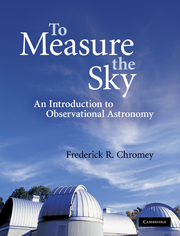6 - Astronomical telescopes
Published online by Cambridge University Press: 05 June 2012
Summary
The adventure is not to see new things, but to see things with new eyes.
– Marcel Proust (1871–1922), Remembrance of Things Past, 1927While I disagree with Proust about the thrill of seeing utterly new things (I'm sorry, that is an adventure), astronomers immediately come to mind if I wonder who might be obsessively concerned with the acquisition of new “eyes.” No instrument has so revolutionized a science, nor so long and thoroughly dominated its practice, as has the telescope astronomy. With the possible exception of the printing press, no instrument so simple (amateurs still make their own) has produced such a sustained transformation in humanity's understanding of the Universe.
In this chapter, we examine the basic one- and two-mirror optical layouts of the preferred modern designs, as well as the layouts of a few telescopes that use both transmitting and reflecting elements. Schroeder (1987) provides a more advanced treatment.
Space-based telescopes have some pronounced advantages, disadvantages, and special requirements compared with their ground-based cousins, and we will consider these in some detail, along with recent advances in the construction of very large telescopes. Because it is such an important technology, we will take some trouble to understand the principles of adaptive optics, and its potential for removing at least some of the natural but nasty (for astronomy) consequences of living on a planet with an atmosphere.
- Type
- Chapter
- Information
- To Measure the SkyAn Introduction to Observational Astronomy, pp. 157 - 195Publisher: Cambridge University PressPrint publication year: 2010

